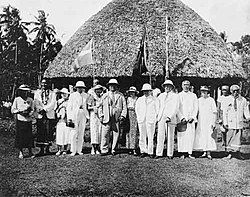Safune
Olaf Frederick Nelson, a leader of the Mau, Samoa's independence movement during the colonial era in the early 1900s, was born in Safune on 24 February 1883.
[1] In Samoan mythology, the fresh spring pool Mata o le Alelo, in the village of Matavai in Safune is associated with the Polynesian legend of Sina and the Eel.
[3] The London Missionary Society, which was established by evangelical Anglicans and Nonconformists, largely Congregationalist in outlook, was active in the 19th century.
[6] The tropical landscape of Safune was very different from the frozen icy setting of Flaherty's previous film Nanook of the North.
Frederick O'Brien (1869 - 1932),[7] a successful travel writer in America in the 1920s (Atolls of the Sun, Mystic Isles of the South Seas) had stayed for several months in Safune and recommended the village to Flaherty as a location for his film.
The German had trained as an opera singer in his youth in Europe and provided evening recitals in the village including operatic renditions of Siegfried's death scene from Götterdämmerung.
[6] Flaherty made the film in Safune with the approval of the chiefs (matai), of whom the filmmaker noted as being proud of their home being chosen as the location.
Flaherty exposed about 240,000 feet of negative on the Safune family, a large amount of footage developed and printed by hand in a cave with two Samoan boys who had no prior film training.
After a year of filming, a problem showed up in the developed negative, caused by the salinity content of the water from the pool in the cave laboratory.
The film showed the young hero getting a pe'a, a rite of passage, and the traditional Samoan tattoo for males.
The old woman making 'tapa' in the film was Tu'ugaita of the Pa'ia'aua family in Matavai village, where the Mata o le Alelo pool is situated.
By the time Flaherty and his family departed Safune, they had formed a close kinship bond with the people of the village.

